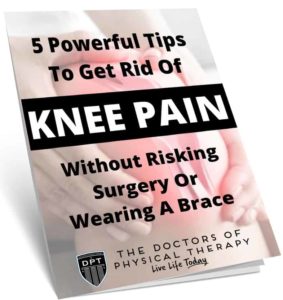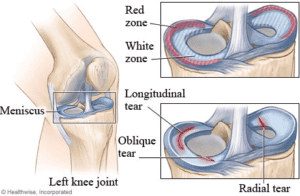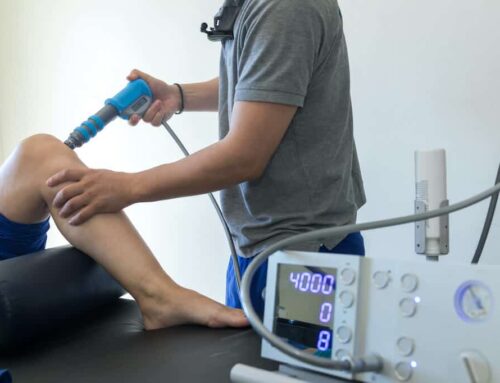A torn meniscus is one of the most common knee injuries. It typically happens during a ‘plant and twist’ motion. This can be during sports that require quick changes in direction, but may also happen at seemingly random times when you’re simply walking.
What does a torn meniscus feel like?
The meniscus is a C-shaped cartilage in between your thigh bone and your tibia. You have one on the inside of your knee, and one on the outside (see image below).
The meniscus is supposed to help the knee absorb shock when you’re walking, jumping, or running. Either one of these pieces can tear anywhere along the cartilage leaving you with pain when you walk, stand, or jump.
Most commonly, the one on the inside part of your knee tears, leaving you with pain along the inside of your knee. It’s also very common to have pain in the back of your knee. It can vary depending on which part tears.
What are other symptoms of a torn meniscus?
Other symptoms include:
- Popping
- Swelling
- Stiffness
- Clicking
- Locking – making it difficult to bend or straighten your knee
- Pain with weight bearing and twisting side to side
- Feeling your knee give way
How is a torn meniscus diagnosed?
A torn meniscus can be diagnosed by a physical therapist during a physical examination. If the tear requires further diagnosis, an MRI may be used. An x-ray will not tell you if a meniscus is torn, but can rule out other issues.
What is the treatment for a torn meniscus?
More importantly…can it heal on its own or is surgery required?
There are several different types of meniscus tears. The good news is that most of them can be healed conservatively – meaning without surgery.
There are important things to think about when healing from a meniscus tear. When you have a meniscus tear, the muscles around your knee will tighten, typically you will have tight calves.
When the muscles around the knee tighten, they’re trying to help with the healing process. They are trying to brace the knee, to control motion, so that the tear can heal. The problem is that this also causes compression in the knee. This compression, left unchecked, can cause worsening of meniscus health and lead to arthritis over time.
For this reason, the best way to make sure you’re healing your torn meniscus and not creating new problems is to consult with an expert physical therapist.
What can a physical therapist do for a torn meniscus?
An expert physical therapist will be able to help you to:
- Diagnose that you have a torn meniscus
- Identify WHY the meniscus is torn
- Figure out what muscles are now compensating and guarding the knee
- Help you put together a plan to fix it and prevent it from happening again
The reason working with an expert physical therapist is important is that there are multiple reasons your meniscus might have torn. These reasons can include hip weakness, muscle tightness, or bad movement habits. These are things that cause people to have multiple meniscus tears over time. The more you tear your meniscus, the higher the chances are that you need surgery.
The problem with surgery, is that most often it involves removing torn cartilage from your knee. This helps with the pain, but do you remember what the meniscus was for? If you guessed shock absorption, you’re right on the money.
Without your meniscus to absorb shock, your bones and cartilage have to do it. This leads to arthritis, and increases the chances you need a knee replacement later in life.
As you can see, there are many reasons to investigate PT vs. Surgery for torn meniscus.
blog image: https://www.healthpages.org/surgical-care/knee-arthroscopy/
If you’re wondering what else you can do about your torn meniscus see our page about knee pain. There’s a free guide with tips that can help you towards becoming more active, healthy, and mobile without painkillers or surgery.
Image Credits: healthwise




